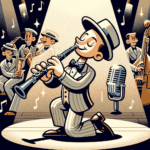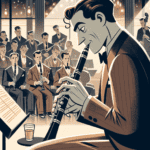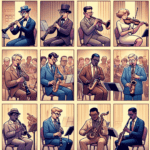When we talk about the clarinet in the big band era, we're looking at one of the most influential periods for this instrument in popular music. The clarinet was a key part of swing music, which ruled the airwaves and dance halls from the 1930s to the late 1940s. Names like Benny Goodman, Artie Shaw, and many others left their mark with dazzling clarinet solos.
But how did the clarinet become so central? Its versatility fit the big band sound perfectly. It could handle smooth, flowing melodies and quick, complex passages that defined swing music. The clarinet's range and expressive qualities made it perfect for both solos and ensemble parts.
The Golden Age of the Clarinet
In the big band era, the clarinet shone not just for its musical abilities but for the personality it brought to the stage. Benny Goodman, nicknamed the ‘King of Swing,' put the clarinet in the spotlight like never before. His skill and innovative style raised the bar for clarinetists everywhere.
Artie Shaw was famous for his flawless technique and ability to express deep emotion through his clarinet. His rendition of ‘Begin the Beguine' took listeners on a journey, showing how the clarinet could captivate an audience.
Other big band clarinetists like Jimmy Dorsey and Woody Herman added to the era's rich musical landscape. Each musician brought their own style, revealing the clarinet's wide range of possibilities.
1930s
The clarinet becomes a key instrument in big band and swing music.
1938
Benny Goodman's Carnegie Hall concert popularizes swing music and the clarinet.
1940s
Artie Shaw and other clarinetists further develop the instrument's role in big band music.
Late 1940s
The big band era begins to decline, but the clarinet's influence remains strong in jazz.
The Clarinet's Role in the Ensemble
While solo clarinetists dazzled audiences, the instrument also played a vital role within the ensemble. It often acted as a bridge between the reeds and brass, adding warmth and depth to the big band sound. The clarinet's ability to blend with both sections made it essential for full orchestral compositions.
The clarinet's agility allowed it to handle fast passages that could keep up with trumpets and saxophones while also playing lyrical, expressive lines that balanced the overall musical texture.
Clarinet Innovators in Big Band
New techniques and sounds came from endless experimentation. Benny Goodman, for example, pushed what was possible on the clarinet. He practiced for hours, exploring new fingerings and articulation techniques to create the unique sounds that defined his performances.
Artie Shaw also greatly contributed to clarinet technique development. His approach to phrasing and breath control broke new ground. He spent countless hours refining his embouchure and breathing techniques to achieve a sound that was both powerful and delicate.
Among the many musicians exploring the clarinet's potential, Barney Bigard stands out for his work with Duke Ellington's orchestra. Bigard incorporated elements of New Orleans jazz into the big band format, showcasing the clarinet's rich history and its adaptability to different musical styles.
Legacy and Influence
Today, the big band era's clarinet legacy lives on. Modern artists and teachers draw inspiration from the greats of this golden age. Music schools continue teaching the styles and techniques developed during the big band era, ensuring these traditions pass on to new generations of musicians.
High-quality instruments like Martin Freres clarinets help keep this rich history alive. These clarinets allow today's players to explore and expand on the sounds of yesterday. Their excellent craftsmanship and unique tonal qualities make them popular among both professional musicians and students.
Tips for Aspiring Clarinetists
If you're an aspiring clarinetist hoping to capture some of the magic from the big band era, here are a few tips:
- Listen to the Masters: Spend time with recordings of Benny Goodman, Artie Shaw, and other big band clarinetists. Pay attention to their phrasing, articulation, and overall style.
- Practice Regularly: Set aside time each day to practice. Focus on scales, arpeggios, and technical studies to improve your agility and control.
- Explore Different Styles: Try playing various genres that have featured the clarinet. This will help you become more versatile and develop your unique voice.
- Use Quality Instruments and Reeds: Investing in a good clarinet and finding the right reeds can significantly improve your sound.
Remember, music isn't just about perfection; it's about expression. The greatest clarinetists of the big band era weren't just skilled technicians—they were storytellers. So go out there and tell your story through your clarinet playing!







